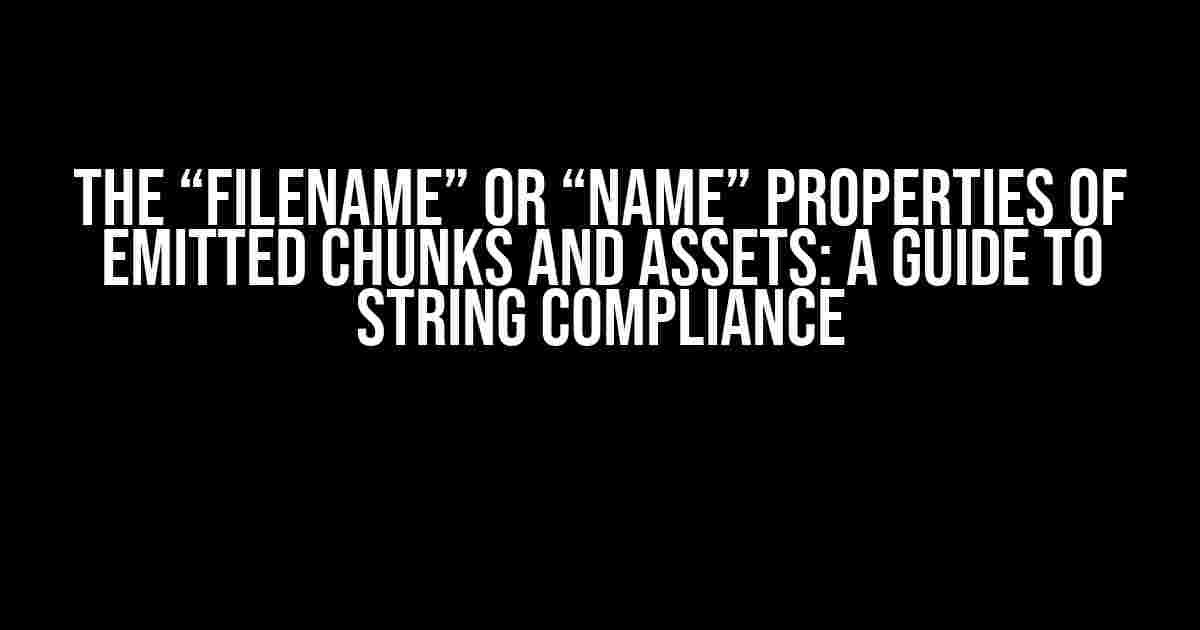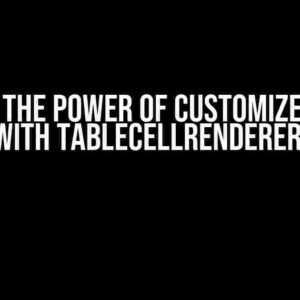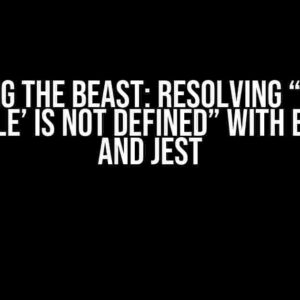As developers, we’ve all been there – stuck in the midst of a complex build process, only to be thwarted by a seemingly innocuous error message. One such error that can bring your entire operation to a grinding halt is the requirement that the “fileName” or “name” properties of emitted chunks and assets must be strings that are neither absolute nor relative paths. Sounds straightforward, but trust us, it’s a gotcha that’s easier to trip over than you think!
What’s the Big Deal About File Names, Anyway?
In the world of bundling and chunking, file names become more than just a way to identify a file. They’re an integral part of the build process, influencing how our bundles are constructed, optimized, and ultimately served to users. When we emit chunks and assets, their file names serve as a unique identifier, allowing our bundler to differentiate between various files and modules.
So, why the fuss about absolute and relative paths? Well, when we use absolute or relative paths in our file names, we’re essentially anchoring them to a specific location on the file system. This can lead to a host of problems, including:
- Conflicting file names
- Invalid manifest entries
- Broken imports and exports
- Inconsistent caching
By keeping our file names as simple strings, we ensure that our bundler can process and optimize them correctly, without getting bogged down by extraneous path information.
Understanding the Error Message
When you encounter the error message “The “fileName” or “name” properties of emitted chunks and assets must be strings that are neither absolute nor relative paths,” it’s typically because your bundler has detected an invalid file name. This can occur due to a variety of reasons, including:
module.exports = {
entry: './src/index.js',
output: {
path: './dist',
filename: '[name].js',
chunkFilename: '[name].chunk.js'
}
};
In this example, the error message might appear because the `chunkFilename` property is using the `[name]` placeholder, which can sometimes resolve to an absolute or relative path. To fix this, we need to modify the `chunkFilename` property to ensure it produces a string that meets the required criteria.
Fixing the Issue: A Step-by-Step Guide
Don’t worry, resolving this error is relatively straightforward. Here are some tips to get you back on track:
-
Review Your Configuration File
Start by reviewing your bundler configuration file (e.g., `webpack.config.js`) to identify any instances where the “fileName” or “name” properties might be using absolute or relative paths.
-
Use placeholders wisely
Be cautious when using placeholders like `[name]`, `[chunkhash]`, or `[contenthash]`. While they can be incredibly useful, they can also lead to invalid file names if not used correctly.
-
Define custom file names
Instead of relying on placeholders, consider defining custom file names using strings or functions that guarantee compliance with the required format.
module.exports = {
entry: './src/index.js',
output: {
path: './dist',
filename: 'bundle.js',
chunkFilename: (chunkData) => `chunk.${chunkData.id}.js`
}
};
-
Verify file names in plugins
If you’re using plugins like `MiniCssExtractPlugin` or `HtmlWebpackPlugin`, verify that they’re not generating file names that violate the rule.
const MiniCssExtractPlugin = require('mini-css-extract-plugin');module.exports = {
// ...
plugins: [
new MiniCssExtractPlugin({
filename: '[name].css',
chunkFilename: '[id].css'
})
]
};
-
Test and iterate
Once you’ve made changes to your configuration file, test your build process to ensure the error has been resolved. If you’re still encountering issues, revisit your file names and try alternative approaches until the error disappears.
Best Practices for File Names
To avoid running into this issue in the future, follow these best practices for crafting file names:
| Best Practice | Description |
|---|---|
| Use descriptive names | Use descriptive file names that indicate their purpose or content, making it easier to identify and debug issues. |
| Avoid placeholders when possible | While placeholders can be convenient, they can sometimes lead to invalid file names. Consider using custom file names or functions instead. |
| Keep it simple | Stick to simple, alphanumeric file names that don’t include special characters or path separators. |
| Test and verify | Regularly test your build process to ensure file names are correct and comply with the required format. |
Conclusion
The “fileName” or “name” properties of emitted chunks and assets must be strings that are neither absolute nor relative paths – it’s a rule that’s easy to overlook, but crucial to the success of your build process. By understanding the root causes of this error, reviewing your configuration file, and following best practices for file names, you’ll be well on your way to resolving this issue and ensuring your builds run smoothly and efficiently.
Remember, a well-crafted file name is not just a trivial detail – it’s a critical component of your bundling and chunking strategy. By taking the time to get it right, you’ll be rewarded with faster builds, fewer errors, and a more maintainable codebase.
Frequently Asked Question
Get the scoop on Webpack’s “fileName” and “name” properties for emitted chunks and assets!
What’s the deal with “fileName” and “name” properties having to be strings?
The “fileName” and “name” properties must be strings because they’re used to identify and differentiate between emitted chunks and assets. Using strings ensures consistency and avoids potential issues with path separators, making it easier for Webpack to manage and optimize your code.
Why can’t I use absolute paths for “fileName” and “name”?
Using absolute paths would make it difficult for Webpack to determine the correct output location. Absolute paths can also lead to conflicts between different modules and chunks. By using strings, Webpack can generate a unique and consistent naming convention for your emitted files.
Are relative paths allowed for “fileName” and “name”?
Nope! Relative paths can still cause issues, as they can be ambiguous or dependent on the current working directory. By requiring strings, Webpack ensures that the emitted files can be easily identified and referenced without worrying about path-related complexities.
How do I customize the “fileName” and “name” properties for my emitted chunks and assets?
You can customize the “fileName” and “name” properties using Webpack’s built-in plugins and options. For example, you can use the `output.filename` option to control the naming convention for emitted chunks. Consult the Webpack documentation for more information on available plugins and options.
What if I’m using a custom plugin or loader that requires special handling for “fileName” and “name”?
In that case, you may need to configure your custom plugin or loader to work with Webpack’s requirements. Consult the plugin or loader’s documentation for guidance on how to handle “fileName” and “name” properties correctly. If you’re still stuck, reach out to the plugin or loader’s maintainers for support!



